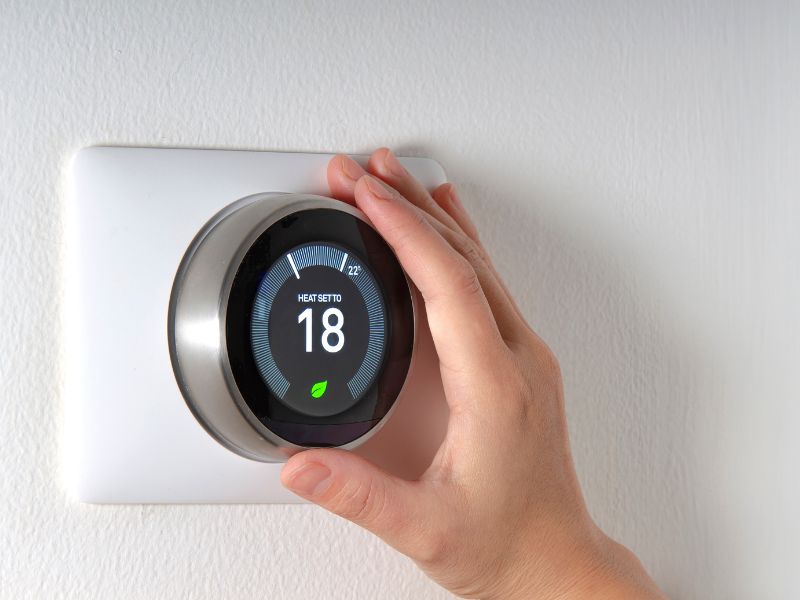Do you know how long your thermostat is supposed to last? If not, you’re not alone. Despite being one of the most important components of your HVAC system, many homeowners don’t give much thought to their thermostat until something goes wrong. But understanding how long a thermostat is designed to last and what factors can impact its lifespan can help you identify potential issues and avoid unexpected breakdowns. So, whether you’re a new homeowner or simply curious about your HVAC system’s lifespan, this article will provide all the information you need to know about the longevity of a thermostat.
Tabe of Contents
1. Introduction: Understanding the Lifespan of a Thermostat
As an essential component of any heating, ventilation, and air conditioning (HVAC) system, the thermostat plays a crucial role in regulating indoor temperature and ensuring comfort for occupants. But just like any other mechanical or electrical device, the thermostat has a limited lifespan – it won’t last forever.
What is a Thermostat?
Before we dive into the lifespan of a thermostat, let’s first define what it is. A thermostat is a device that senses the temperature of an environment and regulates it to a desired setpoint. It communicates with the HVAC system to turn it on or off based on whether heating or cooling is needed, and works by opening or closing electrical contacts or valves.
Thermostats come in various types, from basic mechanical models to advanced programmable or smart thermostats that can be controlled remotely or learn users’ habits. No matter the type, however, all thermostats have a similar lifespan, which can be affected by several factors.
2. Factors that Affect the Lifespan of Your Thermostat
A thermostat is a crucial component of your HVAC system that regulates temperature and keeps your home comfortable. However, like any other mechanical device, it has a limited lifespan. Understanding the factors that impact the lifespan of a thermostat can be useful in maintaining your system at its best.
Installation Quality
The lifespan of a thermostat is greatly influenced by how it was installed. Poor installation practices such as wiring errors, improper calibration, or loose connections can cause malfunctions and shorten the lifespan of your thermostat. That’s why it’s essential to ensure proper installation by seeking the services of an experienced HVAC professional. A professional installer will ensure that your thermostat is correctly wired, calibrated, and functioning efficiently.
Usage Patterns
Another factor that affects a thermostat’s lifespan is how frequently it’s used. The more it’s used, the faster it will wear out. If, for instance, you’re frequently changing the temperature throughout the day, it could cause the thermostat’s sensors to become faulty. On the other hand, if you use energy-saving settings, such as programmable thermostats, it can help extend the lifespan of your thermostat.
Environmental Conditions
The conditions of the environment where your thermostat is located can also impact the lifespan of the unit. For instance, if it’s situated in an area with high humidity, it could cause internal components to corrode and break down, reducing the lifespan of your thermostat. Similarly, if it’s located in direct sunlight or an area with significant temperature fluctuations, it may malfunction sooner.
Understanding the can help ensure that your HVAC system operates smoothly and efficiently. By keeping track of these factors, you can take preventive steps to prolong the lifespan of your thermostat, which can help you avoid frequent replacements and save you money in the long run.
3. Signs That Indicate Your Thermostat Is Failing
If you’ve had your current thermostat for a while and you’re concerned about whether it’s functioning properly or not, then here are some signs to look out for:
- Temperature inaccuracy: If you notice that the temperature in your home is not properly regulated or the thermostat is displaying the wrong temperature, then it may be a sign that your thermostat is failing. This issue could be due to the buildup of dust and dirt interfering with the thermostat’s sensors or wiring problems.
- Uneven heating or cooling: If your heating or cooling system is working fine, but some areas or rooms in your home are warmer or cooler than others, then it may indicate a thermostat problem. This issue could be caused by problems with the thermostat calibration or your heating or cooling system.
- Constant cycling on and off: If you notice that your heating or cooling system is constantly turning on and off, it could be because of a malfunctioning thermostat. Cycling on and off could eventually lead to equipment failure, which could result in costly repairs.
If you experience any of these issues, it may be because of a malfunctioning thermostat. To be sure, you can have an HVAC technician inspect your system to identify any faults or problems with your thermostat.
4. How to Prolong the Lifespan of Your Thermostat
Your thermostat plays a crucial role in controlling the temperature in your home. To ensure that your thermostat lasts as long as possible, there are a few steps that you can take. Here are some tips to help prolong the lifespan of your thermostat.
1. Regular Maintenance
One of the best things that you can do to keep your thermostat working smoothly is to perform regular maintenance. This includes cleaning the thermostat on a regular basis and ensuring that it is free from any dust or debris. It is also a good idea to check the wiring to ensure that it is securely connected and not damaged.
2. Keep it away from direct sunlight and heat sources
Thermostats are designed to operate within certain temperature ranges. Exposure to excessive heat or direct sunlight can cause your thermostat to malfunction or wear out faster than usual. Keep your thermostat away from heat sources such as radiators, ovens or direct sunlight.
3. Adjust the temperature settings
Thermostats can last longer if they are not forced to work too hard. Adjusting the temperature settings in your home can help your thermostat work less, which in turn can prolong its lifespan. Turning down the heat a few degrees during the winter and turning up the air conditioning a few degrees during the summer can help your thermostat last longer.
4. Schedule Professional Maintenance
While regular maintenance is helpful, scheduling professional maintenance for your heating and cooling system can help your thermostat last longer. A professional technician can diagnose any potential problems and perform any necessary repairs before they develop into more significant issues that affect your thermostat.
By following these simple tips, you can help prolong the lifespan of your thermostat. Proper maintenance, keeping it away from direct sunlight and heat sources, adjusting the temperature settings and scheduling professional maintenance are all ways to help ensure that your thermostat lasts as long as possible.
5. Upgrading to a New Thermostat: Is it Necessary?
At some point, you may start to consider upgrading to a new thermostat. But is it really necessary? While it ultimately depends on your specific situation, there are a few factors to consider.
Energy Efficiency
If your current thermostat is not energy efficient, it may be worth upgrading. Newer models offer features like programmable schedules and remote access that can help you save money on energy bills. Additionally, newer thermostats are often more accurate, which can help you maintain a comfortable temperature in your home without wasting energy.
Compatibility
If you’ve recently upgraded your HVAC equipment, you may need a new thermostat that is compatible with your system. For example, if you have a heat pump, you may need a different type of thermostat than if you have a traditional furnace or air conditioner. It’s important to check with a professional HVAC technician to ensure that your new thermostat is compatible with your system.
Cost
While upgrading to a new thermostat can help you save money in the long run, it’s important to consider the initial cost. Thermostats vary in price, and you’ll want to choose one that fits your budget. Additionally, you’ll need to factor in any installation costs if you’re not comfortable installing the thermostat yourself.
Overall, upgrading to a new thermostat is not always necessary, but it can be beneficial in certain situations. Consider your energy efficiency, compatibility, and cost before making a decision.
People Also Ask
How often should you replace your thermostat?
Thermostats typically last for around 10 to 15 years. However, it is a good idea to replace your thermostat every 10 years to ensure that it is functioning correctly.
What are the signs that a thermostat is going bad?
Signs that your thermostat may be going bad include inconsistent temperature readings, short cycling, or unresponsive controls. If you are experiencing any of these issues, it may be time to replace your thermostat.
Can a bad thermostat cause a high electric bill?
Yes, a malfunctioning thermostat could cause your electricity bills to skyrocket. If your thermostat is failing to keep your home at a consistent temperature, your HVAC system will have to work harder, using more energy and leading to a higher electric bill.
What happens when a thermostat goes bad?
When a thermostat goes bad, it can cause your home to be too hot or too cold. It can also damage your HVAC system by causing it to short cycle or overheat.
How much does it cost to replace a thermostat?
The cost of replacing a thermostat can vary depending on the make and model of your HVAC system. On average, you can expect to pay between $100 and $300 for a new thermostat, including installation costs.
Conclusion
Thermostats typically last for around 10 to 15 years before needing to be replaced. Signs that your thermostat may be failing include inconsistent temperature readings, short cycling, or unresponsive controls. If you are experiencing any of these issues, it may be time to replace your thermostat to ensure that your HVAC system is functioning correctly.

Bobby leads Air Conditioners Contractors with a vision for innovation and excellence in the HVAC industry. With a passion for customer satisfaction and a drive for technological advancement, he ensures the company remains at the forefront of delivering top-tier air conditioning solutions across the USA. His leadership fosters a culture of dedication, expertise, and commitment to exceeding client expectations.

